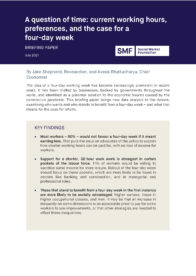The idea of a four-day working week has become increasingly prominent in recent years. It has been trialled by businesses, backed by governments throughout the world, and identified as a potential solution to the economic trauma caused by the coronavirus pandemic.
This briefing paper brings new data analysis to the debate, examining who wants and who stands to benefit from a four-day week – and what that means for the case for reform.
Key points
- Most workers – 80% – would not favour a four-day week if it meant earning less. That puts the onus on advocates of the policy to explain how shorter working hours can be paid for, with no loss of income for workers.
- Support for a shorter, 32-hour work week is strongest in certain pockets of the labour force. 11% of workers would be willing to sacrifice some income for more leisure. Rollout of the four-day week should focus on these pockets, which are more likely to be found in sectors like banking and construction, and in managerial and professional roles.
- Those that stand to benefit from a four-day week in the first instance are more likely to be socially advantaged: higher earners, those in higher occupational classes, and men. It may be that an increase in inequality on some dimensions is an acceptable price to pay for some workers to see improvements, or that other strategies are needed to offset these inequalities.

DOWNLOAD THE briefing PDF
